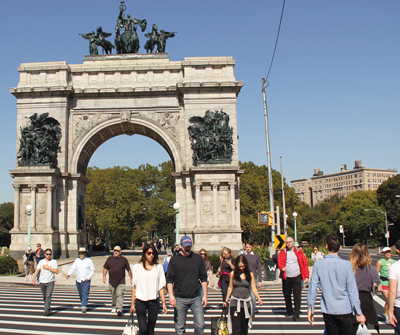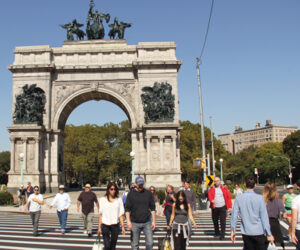In March 2006, the Park Slope Civic Council devoted its annual community forum to issues of traffic and transportation. More than 200 audience members gathered in the Old First Reformed Church’s sanctuary to listen to panelists discuss traffic calming and placemaking, residential parking permits and Atlantic Yards, and more. Given a chance to weigh in on the challenges they found on local streets, residents cited Grand Army Plaza’s inaccessibility and speeding on Prospect Park West as two of Park Slope’s most pressing transportation-related problems.

Before the night had ended, the wheels of positive and potentially life-saving change were already in motion. After the event officially ended, a group of newly energized Brooklynites sat down in Old First’s pews and started batting ideas back and forth. Before they left, the outlines of the Grand Army Plaza Coalition (GAPCo) were born, with the Civic Council as a charter member.
Two months later, members of the nascent GAPCo took to the plaza to survey traffic, pedestrian, and cycling conditions, noting what worked and what didn’t. The next spring, GAPCo convened a workshop at the Brooklyn Public Library, overlooking the plaza. More than 50 residents, local activists, elected officials, and transportation experts brainstormed ways to make the space more inviting and safer for pedestrians, cyclists, and drivers.
Those efforts quickly bore fruit. Just six months later, the New York City Department of Transportation (NYCDOT) announced several improvements to Grand Army Plaza, including the conversion of more than 10,000 square feet of asphalt into raised pedestrian islands, marked crosswalks, and a protected bike path facilitating connections with the existing Plaza Street East bike lane. The enhancements were a direct outgrowth of GAPCo’s work — and were just a preview of things to come.
Last April, NYCDOT announced the next phase in the ongoing effort to remake Grand Army Plaza. Those startling — and widely welcomed — changes, implemented by NYCDOT this summer, have greatly advanced GAPCo’s goal of transforming Grand Army Plaza from a traffic maelstrom into one of Brooklyn’s — and the world’s — great public spaces.
The new design has remade the intersection of Flatbush and Vanderbilt Avenues to the north into a vastly more pedestrian-friendly space. It has added a new curb and signal for vehicles bound toward Prospect Park West and Union Street, simplifying what was a breakneck merge across six lanes of traffic. It has added several large pedestrian islands and crosswalks on the southern end of the plaza, and expanded and physically protected the area devoted to the Greenmarket. The redesign also added several new bike routes that make cycling through the plaza easier and safer.
A similar process, with similar results, has played out on Prospect Park West. Community Board 6 told NYCDOT in June 2007 that the roadway needed serious traffic calming, suggesting that one of three vehicular travel lanes could be replaced with a two-way protected bike path. Local advocacy group Park Slope Neighbors picked up the ball in March 2009, sending NYCDOT 1,300 signatures on a petition asking for much the same thing. The agency responded not long after, presenting a plan removing excess capacity and adding the bike route that is there today. Over the next year, the plan was refined, then implemented in June 2010. Almost overnight, the changes had the intended traffic-calming effect, reducing speeding by 75%; soon, the amount of bike traffic more than doubled, while the presence of bikes on Prospect Park West’s sidewalks dropped by 90%.
Like the newly accessible Grand Army Plaza, the new Prospect Park West is just one more example that a little vision and a lot of community engagement can make a complete street out of chaos.
Also arising from the 2006 forum was the Livable Streets Committee, which has initiated a broad spectrum of events and projects that focus on street life — from the way pedestrians, cyclists, and motorists interact to the semi-annual Civic Sweep.
The committee has been included in important conversations on larger initiatives, most recently with NYCDOT’s exciting Bike Share program, which will launch next year. Bike sharing will benefit local businesses and institutions like schools and hospitals. Similar programs are already up and running in some 200 cities worldwide including, in North America, Montreal; the University of California campus in Irvine; Miami Beach; Washington, D.C.; and Mexico City.

In our own communities, where so many locals ride bikes and storage is always a premium, we expect a high demand for Bike Share. On Oct. 1, the Civic Council cosponsored a Bike Share demonstration by NYCDOT at Grand Army Plaza. We are pleased to join in this exercise in community engagement; no less important, we want to open up a dialogue with our local business improvement districts and other business and community leaders on where share stations might be sensibly located. (NYCDOT has posted an interactive map, at www.nyc.gov/bikeshare, where visitors can suggest where bike-share stations might go.) By working together and thinking “out of the box,” we could recommend some smartly situated stations in our communities.
Livable Streets is always open to recommendations and issues affecting our neighbors and neighborhood! It’s our goal to keep Park Slope beautiful, calm, and clean! To learn more, including notifications of upcoming meetings, e-mail livable@parkslopeciviccouncil.org.
— Eric McClure is co-founder of Park Slope Neighbors; Judith Lief is the chair of the Civic Council’s Livable Streets Committee.
from the Fall 2011 Civic News

